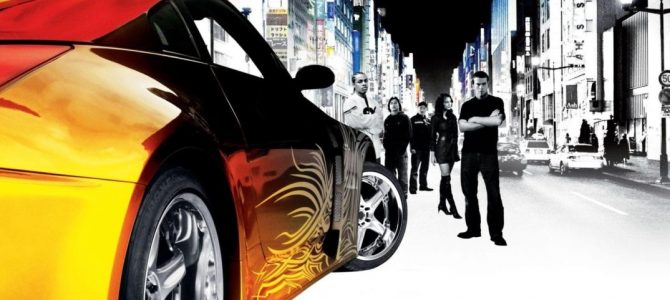
In the world of “Fast & Furious” fandom, the third installment in the series is considered somewhere between “Episode 1” and “The Star Wars Holiday Special.” Orphaned by Vin Diesel after the first movie, and losing steam in the second despite the additions of franchise staples Tyrese and Ludacris, the third movie, “Fast & Furious: Tokyo Drift” debuted a new director and an entirely new cast. Some would like to boot it from the canon entirely. I came to the franchise late but was lucky enough to watch before I was informed of this widespread, unfair “Tokyo Drift” prejudice. “Tokyo Drift” is awesome and you should all try it before you knock it.
Here are four reasons “Tokyo Drift” is a fantastic Fast & Furious.
1. The Opening Race
Every “Fast & Furious” opens with a race scene that sets the tone for the movie.
This one is a doozy. The setting is a typical American high school with typical American villains, love interests and underdog heroes. Sean Boswell, a southern kid from the wrong side of the tracks played by Lucas Black, gets into a conversation with the football star’s girlfriend in the parking lot.
A race ensues— the problematic prize being the girl herself, of course—through a burgeoning subdivision and all the obstacles that entails. Retention ponds, piles of drywall, half-built McMansions and concrete barrels! A giant, beater Monte Carlo that Boswell the wrencher has presumably souped up vs. a brand-new Dodge Viper. Because of its place in the series, “Tokyo Drift” is still bound by the laws of physics in ways later films are not, and this race is great because you’re unsure how it could end for our new hero and his classmates, who have no veneer of Vin Diesel invincibility.
2. The Director
This first race also sets the tone for director Justin Lin, who came on for 3 and midwifed the franchise through its rebirth into action-movie juggernaut, directing what is widely recognized as the best movie of them all— “Fast 5.”
Justin Lin’s Tokyo is colorful, with its meat-and-potatoes lead a contrast to the cotton-candy scenery and neon car scene that animates the city’s claustrophobic parking garages. Lin takes advantage of Japanese tuner culture and technology—exotic vending machines and new-fangled flip phones with video capability!— but moves the action out to the mountains for serene training scenes in the art of “drifting.” Lin proved to have a bead on the F&F style early really brought it to fruition throughout his tenure in a way that built the franchise.
3. The Mentor Relationship
This movie is the introduction of Han, who later becomes very important in subsequent F&Fs (we later learn movie order and F&F chronology are not linear, so that Lin can monkey with the timeline with mindblowing results, but I digress). I was also recently informed that Han’s full name is Han Seoul-Oh. No, really. Han’s placid confidence and great hair are a boon to the franchise that can’t be ignored. And, though Black’s character is not beloved by F&F fans, Han’s obvious confidence in him makes him a real part of “The Family,” whether you like it to not. After losing his legendary car by letting the inexperienced Boswell race it in a contest everyone knew he’d lose, Black’s character asks why. Han’s response:
“I have money. It’s trust and character I need around me…One car in exchange for knowing what a man’s made of? That’s a price I can live with.”
Further, Black’s character should be beloved. He and Bow Wow, who I will concede is a comedown from Ludacris in a supporting role, have good chemistry and Black’s accent alone—it’s all real— is worth the price of admission. Born in Decatur, Alabama, Black was first known as a child actor in “Slingblade” and “Ghosts of Mississippi,” and brings an understated Southern swagger to this fish-out-of-water story.
4. A Joyful Cultural Mash-up
But the best thing Black brings, and Bow Wow too, is what defines the “Fast & Furious” series— a joyful collision of a bunch of cultures and very diverse people in a tuner/gearhead/wrenching subculture that celebrates all of them.
The original inspiration for the “Fast & Furious” series was a 1998 Vibe article about street racing in New York City, which featured a Rafael Estevez uttering some of the most Fast & Furious quotes that have ever been uttered.
“People say I cheat all the time,” explains Estevez, a Huck Finn grin spreading across his face. “They say I jump the line, I do this, I do that. Drag racing is war. If you bring a knife, and I bring a machine gun, you’re dead. That’s it.”
The series is certainly true to this inspiration, but “Tokyo Drift” is perhaps truest of all. The franchise has always mixed American muscle cars with smaller, nos-driven foreign models. Estevez “remembers being transfixed by TV’s The Dukes of Hazzard” as a kid but drives a Nissan 300ZX.
“The best part was they would always get away,” he told Vibe.
“Tokyo Drift” ends with the embodiment of this cultural mash-up— an American kid driving a restored ’67 Ford Mustang with a Nissan Silvia’s engine down the side of a Japanese mountain. Maybe a Dodge Charger would have been a little too on-the-nose.
For more on this delightful movie series, listen to Kristen Soltis Anderson and I discuss it on Federalist Radio, and never trust this guy on the subject.









